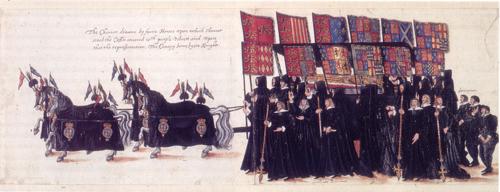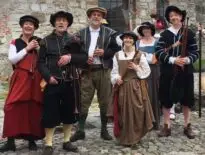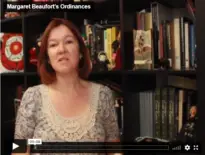
Funeral procession of Elizabeth I
People all over the world have tuned in to watch the funeral of Queen Elizabeth II today, a queen who reigned for over 70 years and who was descended from Margaret Tudor, Queen of Scotland, and, therefore, King Henry VII, as well as having Boleyn blood.
The funeral procession and ceremony were full of tradition and ritual, and our Tudor ancestors would recognise much of it, so I thought I'd share with you some information on Tudor royal funerals.
The funeral of Queen Elizabeth of York
On 23rd February 1503, Elizabeth of York, Queen Consort of Henry VII and mother of Henry VIII, was laid to rest at Westminster Abbey. Elizabeth had died on her 37th birthday, on 11th February, nine days after giving birth at the Tower of London.
In The Last Medieval Queens: English Queenship 1445-1503, J L Laynesmith writes of how at least £3,000 was spent on Elizabeth’s funeral, compared to the £600 spent on that of Arthur, Prince of Wales, the previous year, and that “the whole process was rich with references to the queen’s coronation”. Following ten days of lying in state at the Tower, the queen’s remains were conveyed to Westminster Abbey using the very same route that was used in coronation ceremonies. Her coffin, topped with an effigy of Elizabeth wearing her robes of estate and crown, and holding her sceptre, was placed on cushions of black velvet and blue cloth of gold in a carriage. The carriage was escorted by knights bearing banners displaying the royal arms and images of saints and the parents of the king and queen, and the procession was led by 200 poor people bearing torches, followed by members of the royal household, clerics, and the mayor of London. Behind the carriage bearing Elizabeth’s coffin, were noblewomen, other officers of the City of London and more members of the royal household.
When the procession reached Westminster Abbey, the coffin was placed on a hearse decorated with black cloth of gold emblazoned with the queen’s motto, humble and reverent, and royal emblems. The coffin then lay in state overnight, with watchers and torchbearers, while a supper was held in Elizabeth’s chamber, presided over by her sister, Katherine of York.
On 23rd February. Elizabeth’s funeral took place, with her sister, Katherine, acting as chief mourner. 1,000 candles burnt around her coffin with 273 tapers burning above black cloths that hung from the roof of the abbey. Two masses and then a requiem mass were said before the ladies departed and the burial took place. The Bishop of London blessed the grave, the effigy was removed from the coffin and then the coffin was lowered into the grave. The queen’s officers then broke their staffs of office and threw them into the grave, symbolising the end of their service to Elizabeth.
The grave in which Elizabeth was buried in 1503 was in a side chapel. She was later moved to her present resting place in a vault in Henry VII’s Lady Chapel. Her husband joined her after his death in 1509. Their splendid tomb features gilt bronze effigies of the couple, depicting them in prayer. Here is a description of their tomb from the Westminster Abbey website:
“The black marble tomb base is adorned with six medallions in copper gilt representing the Virgin Mary and Henry's patron saints (Michael, George, Anthony, Christopher, Anne, Edward the Confessor, Vincent, Barbara, Mary Magdalene, John the Baptist and John the Evangelist). At either end are coats of arms supported by cherubs. The gilt bronze recumbent effigies can be seen through the fine grille which surrounds the monument. Seated angels balance on the carved frieze at each corner of the tomb, supporting coats of arms They once held pennants in their hands.”
I’ve been lucky enough to see it and it really is beautiful.
Elizabeth’s tomb inscription reads:
“Here lies Queen Elizabeth, daughter of the former King Edward IV, sister of the formerly appointed King Edward V, once the wife of King Henry VII, and the renowned mother of Henry VIII. She met her day of death in the Tower of London on the 11th day of February in the year of Our Lord 1502, having fulfilled the age of 37 years.”
It dates her death to 1502 because Elizabeth died before Lady Day, 25th March, which was when the new calendar year began in those times.
The effigy used in the procession and her funeral still exists and is in the collection of Westminster Abbey, along with that of her husband.
The funeral of King Henry VIII
On 16th February 1547, Henry VIII’s body was interred in a vault in St George's Chapel Windsor, alongside that of his third wife, Jane Seymour. Here is an eye-witness account of the proceedings:
“16 strong Yeomen of the Guard took the coffin and with four strong linen towels, which they had for their fees, let it into the vault near unto the body of Queen Jane Seymour, his third wife. Then the Lord Chamberlain, the Lord Great Master, Mr Treasurer, Mr Comptroller and the Sergeant Porter, breaking their white staves upon their heads in three parts, as did likewise all the Gentleman Ushers, threw them into the grave. Thus the funeral ended, the trumpets sounded in the Rood loft and the company dispersed.”
Today, there is a memorial slab marking his resting place under the Quire of St George's Chapel. As well as containing Henry and Jane, this vault also contains the remains of Charles I and an infant child of Queen Anne, the Stuart queen.
The funeral of Anne of Cleves
On 4th August 1557, there was a requiem mass for Anne of Cleves, fourth wife of the late King Henry VIII, at Westminster Abbey.
After the mass and a “godly sermon”, Anne was buried in a tomb at the abbey. Her tomb is decorated with carvings of a crown and her initials, AC, skulls and crossed bones, and a lion’s head.
Merchant-tailor and diarist Henry Machyn recorded Anne’s funeral in his diary. I have modernised the spelling:
“The 4th day of August was the mass of requiem for my lady princess of Cleves, and daughter to [William] duke of Cleves; and there my lord abbot of Westminster made a godly sermon as ever was made, and [then] . . . the bishop of London sang mass in his mitre; [and after] mass my lord bishop and my lord abbot mitred did [cense] the corpse; and afterward she was carried to her tomb, [where] she lies with a hearse-cloth of gold, the which lies [over her]; and there all her head officers broke their staves, [and all] her hussars broke their rods, and all they cast them into her tomb; the which was covered her corps with black, and all the lords and ladies and knights and gentlemen and gentlewomen did offer, and after mass a great [dinner] at my lord (abbot’s); and my lady of Winchester was the chief [mourner,] and my lord admiral and my lord Darcy went of either side of my lady of Winchester, and so they went in order to dinner.”
The funeral of King Edward VI
On 8th August 1553, fifteen-year-old King Edward VI was buried in a white marble vault beneath the altar of Henry VII’s Lady Chapel in Westminster Abbey. Edward had died on 6th July 1553 but the struggle for the throne, between the heir he had appointed, Lady Jane Grey, and his half-sister, Mary, plus discussions between Mary I and her ministers over his funeral rites, had led to a delay in burial. It was finally decided that Edward would be buried with Protestant rites, the first use of the English Book of Common Prayer for the funeral of a monarch, and it was Thomas Cranmer, Archbishop of Canterbury, who performed the service.
Merchant-tailor Henry Machyn recorded the funeral procession in his diary:
“The 8th day of August was buried the noble king Edward the vi, and 7th year of his reign; and at his burying was the greatest moan made for him of his death as ever was heard or seen, both of all sorts of people, weeping and lamenting; and first of all went a great company of children in their surplices, and clerks singing; and then his father’s bedmen, and then 2 heralds and then a standard with a dragon, and then a great number of his servants in black, and then another standard with a white greyhound, and then after a great number of his officers and after them came more heralds, and then a standard with the head officers of his house; and then heralds, Norroy bore the helmet and the crest on horseback, and then his great banner of arms embroidered, and with diverse other banners, and then came riding master Clarenceux with his target, with his garter, and his sword, gorgeously and rich, and after Garter with his coat armour embroidered, and then more heralds of arms; and then came the chariot with great horses trapped with velvet to the ground, and every horse having a man on his back in black, and every one bearing a banner-roll of diverse kings arms, and with escutcheons on their horses, and then the chariot covered with cloth of gold, and on the chariot lay on a picture lying richly with a crown of gold, and a great collar, and his sceptre in his hand, lying in his robes and the garter about his leg, and a coat in embroidery of gold; about the corpse were borne four banners, a banner of the order, another of the red rose, another of queen Jane (Seymour), another of the queen’s mother. After him went a goodly horse, covered with cloth of gold unto the ground, and the master of the horse, with a man of arms in armour, which was offered, both the man and the horse. There was set up a goodly hearse in Westminster abbey with banner rolls and pensells, and hung with velvet about.”
Edward’s half-sister, the Catholic Queen Mary I, did not attend and, instead, had requiem masses sung at the Tower of London for three days beginning on 8th August at Vespers.
Edward’s grave was unmarked until 1966 but his coffin was seen in the 19th century, and it was labelled with a Latin inscription which, when translated, read:
“Edward the sixth by the Grace of God King of England, France and Ireland, Defender of the Faith and on earth under Christ supreme head of the churches of England and Ireland and he migrated from this life on the 6th day of July in the evening at the 8th hour in the year of our Lord 1553 and in the 7th year of his reign and in the 16th year of his age.”
In 1966, a stone was placed in front of the altar of the chapel, marking his burial site and inscribed with the following memorial:
“IN MEMORY OF KING EDWARD VI BURIED IN THIS CHAPEL THIS STONE WAS PLACED HERE BY CHRIST’S HOSPITAL IN THANKSGIVING FOR THEIR FOUNDER 7 OCTOBER 1966.”
The funeral of Queen Elizabeth I
On 28th April 1603, Queen Elizabeth I's funeral took place in London.
After her death on 24th March 1603, the body of Queen Elizabeth I was placed inside a lead coffin and carried by night in a torchlit barge along the Thames from Richmond Palace to Whitehall. There, the Queen was to lie in state until her funeral, giving time for the new king, King James I (VI of Scotland) to travel down to London. While the coffin lay in state, a life-size effigy of the Queen, dressed in her royal robes, was placed on top of it to act as a symbol of the monarchy while there was no monarch in England.
On 28th April 1603, Elizabeth's coffin was carried from Whitehall to Westminster Abbey on a hearse drawn by horses hung with black velvet. The coffin was covered in a rich purple cloth, topped with the effigy of Elizabeth with a sceptre in her hands and a crown on her head. Above the coffin was a canopy supported by six knights, and behind the hearse was the Queen’s Master of the Horse, leading her palfrey. The chief mourner was the Countess of Northampton who led the party of peers of the realm, all dressed in black. Chronicler John Stow wrote:
"Westminster was surcharged with multitudes of all sorts of people in their streets, houses, windows, leads and gutters, that came out to see the obsequy, and when they beheld her statue lying upon the coffin, there was such a general sighing, groaning and weeping as the like hath not been seen or known in the memory of man."
Elizabeth was then buried at Westminster Abbey in the vault of her grandfather, Henry VII, until she was moved in 1606 to her present resting place, a tomb in the Lady Chapel of Westminster Abbey which she shares with her half-sister Mary I. King James I spent over £11,000 on Elizabeth I's lavish funeral, and he also arranged for this white marble monument to be built. The tomb is inscribed with the words:
"Consorts both in throne and grave, here we rest two sisters, Elizabeth and Mary, in hope of our resurrection."
You can see an 18th century copy of the funeral effigy that was carried on Elizabeth I's coffin at the Westminster Abbey Museum and you can also visit the Westminster Abbey page on Elizabeth I's tomb at http://www.westminster-abbey.org/our-history/royals/burials/elizabeth-i.
And here's an interesting talk on the representation of queenship in funeral and burial traditions by historian Lauren Browne...



Leave a Reply